- Preparation and application of nanoceramic material-modified flyash in passive building envelope
Wenjun Yang and Jing Chen*
Hebei Vocational University of Technology and Engineering, Xingtai hebei, 054000, China
This article is an open access article distributed under the terms of the Creative Commons Attribution Non-Commercial License (http://creativecommons.org/licenses/by-nc/4.0) which permits unrestricted non-commercial use, distribution, and reproduction in any medium, provided the original work is properly cited.
The manufacturing of a structure’s exterior walls and top covering seldom uses phase change materials (PCMs). Thus, demonstrating an unsuccessful approach towards enhancing the energy efficiency of said building. The extensive examination that has been carried out over the past two decades has revealed the potential abilities of PCMs in terms of energy preservation in building envelopes. However, the significant fiscal burden associated with PCMs’ use has prevented their widespread adoption. This scholarly article provides a thorough assessment of a unique PCM that incorporates naturally occurring fatty acids and glycerides into flyash pellets, while also assessing its performance in relation to applications involving building envelopes. To attain an intended result, the PCM-flyash pellets were combined with nanoclay ceramic insulation. sprayed to a test building outside wall and observed over several months in a hot, humid environment. In order to demonstrate how well the PCM-flyash-enhanced nanoclay insulation reduces heat gains and losses in the building envelope, A comparison was done using a section of wall that was entirely insulated with nanoclay ceramic material. To further comprehend how the PCM-flyash pellets influenced the wall heating as well, the test wall’s numerical modelling was conducted. Experimental data were used to test the concept initially. Then the experimental data was compared with the computational analysis presented in this study, which thereby demonstrated the new PCM incorporated flyash nanoclay material potential for energy-saving in building envelops.
Keywords: Nanoceramic, Fly ash, Building envelope, Energy efficiency, Phase change material.
Industrialization has been indisputably linked to the modern economy as the world has advanced. Coal-powered power sectors support every area of the economy and every developing country. Due to the power sector’s increasing reliance on coal, fly ash production is increasing significantly every year. Everyone is becoming worried about the impact of the large-scale generation of fly ash on the environment. Due to increased environmental concerns, rising land prices, Due to issues with leaching and population growth, fly ash cannot currently be disposed of through land. Hence, the exploration of fly ash’s applications in different domains has attracted continuous scholarly interest due to its capacity to foster a sustainable and improved future. Natural resources are disappearing considerably more quickly as a result of urbanization and the enormous population growth, which is giving all the forerunners in research, development, and industry tremendous headaches. Building materials like cement, fine aggregate, and natural coarse aggregate are in high demand in emerging nations like India to sustain their construction industry. Therefore, creative fly ash use in buildings will not only address fly ash disposal issues but will also aid in preventing the depletion of mineral resources.
According to past studies, space heating and air conditioning account for roughly 48% of all residential end-use energy consumption. Building envelopes must be more affordable and energy-efficient if high-performance, energy-efficient structures are to be developed. In various applications, Phenomena such as solar water heaters with nonintegrated collector storage [1], the control of spacecraft temperature in challenging environments [2], the control of thermal conditions in nonintegrated solar panels on structures [4]. Additionally, phase-change slurries can be used for passive cooling [3]. have resulted in limited attention being paid to PCMs owing to their thermal storage capabilities. It has been surprisingly underutilised over the past 20 years to leverage PCMs’ hidden heat capacities in building envelopes to reduce the heating and cooling loads produced by these envelopes [5].
Building improvement efforts have been driven by the requirement for increased energy efficiency. Buildings have been constructed to use less energy and to intelligently adjust the interior temperature. The usage of PCMs in application development is emerging and has a lot of potential to address these problems. It is feasible to attain storage and emission impacts for achieving thermal satisfaction in structures, Using PCMs with transition temperatures between 20 and 40 degrees Celsius is essential in the domains of thermal energy storage and thermal insulation.
This research discusses the effectiveness of a novel PCM for a building envelope application made of fatty acids and glycerides trapped in waste fly ash. The mixture of PCM-flyash and nano-clay ceramic insulation was combined in an area characterized by high temperatures and humidity. This mixture was subsequently applied to an outer wall of a building designated for testing. Over the span of several months, this mixture underwent rigorous examination during both the summer and winter seasons.
In addition, current research has demonstrated the many uses of PCMs in building envelopes, including raising sustainability, decreasing energy use, and boosting thermal comfort [12]. For example, PCM-enhanced building materials have been used in thermal energy storage solutions, temperature control in harsh locations, and passive cooling systems. Furthermore, the integration of PCM into building envelopes has demonstrated encouraging outcomes in terms of lowering peak loads, enhancing interior thermal stability, and minimizing temperature swings, all of which enhance overall energy efficiency and comfort for occupants.
Additionally, the possible uses of PCM-based building materials have increased due to breakthroughs in PCM technology, including the creation of innovative PCM formulations and integration methods. Phase change temperature, latent heat capacity, and thermal conductivity are examples of PCM qualities that have been optimized recently in order to improve performance and suit a variety of building types and climates [15, 26, 27].
This study seeks to give useful insights into the efficacy and potential of PCM-fatty acid-glyceride-fly ash composites in building envelope applications by clarifying the broad range of applications and current breakthroughs in PCM technology [18, 20]. The project aims to further sustainable building materials and energy-efficient construction techniques through experimental assessment and analysis.
Test facility and Test wall details
Building envelope assemblies are tested at the facility when subjecting to actual weathering. The facility has a southeast wall with numerous side-by-side test walls. The two portions of the test wall are labeled A and B. Section ‘B’ contains the PCM-flyash-nanoclay insulation, and ‘A’ is filled with ordinary nanoclay insulation. The baseline was the conventional nanoclay insulating portion. Since installing the PCM using method “B” is recommended and state “A” is the default, a PCM-flyash layer was sandwiched between layers of nanoclay, this article solely includes additional information, experimental data, and simulation findings from sections ‘A’ and ‘B’. A 14 cm (5.5 in.) deep wall cavity was created by using 2 × 7 wood studs during construction, and an OSB panel measuring 1.3 cm (0.5 in.) thick was affixed to the wall’s exterior side.
Two types of insulation materials were used for the experimental investigation: traditional nanoclay insulation and PCM-flyash-nanoclay composite insulation. The PCM-flyash-nanoclay insulation was made of ceramic nano-clay particles mixed with fly ash pellets that had fatty acid and glyceride incorporated in them. The only component of traditional nanoclay insulation was ceramic nano-clay.
The PCM-nanoclay insulation had 20% by weight of PCM nominally. The PCM-flyash pellet design resulted in a 66% paraffin by-weight content for the flyash pellets. As a result, 0.45 kilogram of PCM-flyash pellets were added for every kg of nanoclay to achieve a pellet content of 30% by weight in the mixture. It should be emphasized that the PCM-flyash-nano clay insulation was mixed with ordinary nanoclay and poured into the cavities from the top, where it was then allowed to settle by gravity. As a result, it was anticipated that the insulation densities of the nanoclay and PCM-nanoclay would differ from those of blown-in clay used for conventional residential wall applications. As shown in Fig. 1, fibreglass insulation was applied to the test wall’s outside cavities after installation in order to thermally isolate it from the other test walls. More insulation made of nanoclay was used to plug any holes that were found at the top of the chambers as a result of the insulation settling. The test wall’s final interior and external faces are also depicted in Fig. 1.
In order to provide thermal isolation from adjacent sections, fiberglass insulation was placed to the test walls’ outside cavities after the insulation was installed. To ensure uniform insulation density throughout the wall cavities, any holes or gaps caused by settling were filled with more nanoclay insulation.
The interior surface was encompassed by a Gypsum board having a dimension of 1.2 cm (0.4 in). A weather-resistant shield was provided by a high-density polyethylene sheet measuring 0.15 mm in thickness, in addition to vinyl siding, with the purpose of safeguarding the outer oriented strand board (OSB) surface. Four (4) temperature sensors, one in the middle of each section/wall cavity, are also visible on the internal face of the device.
Instrumentation and Data Acquisition
A wide range of sensors and instruments were used to monitor the temperature and heat flow at different points within each test wall segment. To measure the amount of heat flow across the wall assembly, heat flux transducers were placed on the OSB and gypsum surfaces and pointed towards the wall cavity. In order to monitor the temperature and humidity levels, thermocouples and relative humidity (RH) sensors were carefully positioned inside the cavities and on both the inner and external surfaces of the gypsum board. The external OSB surface also has thermistors placed to record changes in ambient temperature. A complex network of sensors and instrumentation was used to measure temperature, humidity, and heat flow inside the test wall sections. Included in the instrumentation setup were:
• Heat Flux Transducers: Oriented strand board (OSB) and gypsum surfaces were fitted with heat flux transducers facing the inner cavity. By measuring the heat flux across the wall assembly, these transducers were able to measure the thermal energy that was transferred through the materials.
• Thermistors and Relative Humidity (RH) Sensors: These two components were merged to create T/RH sensors, which were then carefully positioned inside the wall cavities. To be more precise, a thermistor was installed in the cavity at mid-depth to track interior temperatures. In order to monitor temperature variations throughout the wall assembly, thermistors were also mounted on the gypsum board’s hollow and inner facing surfaces.
• Sensor Placement & configuration: Every test wall section had a consistent sensor configuration, with equipment placed roughly midway between each portion’s vertical and horizontal lengths. The wall assembly’s whole temperature and humidity range was covered by this linear configuration.
• Surface Sensors: T/RH sensor pairs and a single thermistor were attached to the OSB surface, especially on the inner side of the siding that was exposed to the inside and external environments of the wall. These surface sensors provide information on how changes in humidity and ambient temperature impact the outside surface of walls.
• External Monitoring instruments: The test facility’s location was the location of extra sensors and monitoring instruments that were part of the experimental setup. The monitoring of environmental factors including temperature, humidity, sun irradiance, and wind speed was made easier by these external sensors. In order to capture fluctuations in weather patterns and environmental impacts on the test walls, data from these exterior sensors were averaged and recorded at regular intervals.
• Data Acquisition and Monitoring System: Real-time data collecting and archiving were made possible by the use of a specialized system for data acquisition and monitoring. The temperature, humidity, and heat flow dynamics were precisely monitored by recording sensor readings every five minutes and recording measurements hourly. Weekly data downloads were made possible by a specific PC and modem configuration, enabling thorough data interpretation and analysis.
The experimental investigation was able to provide comprehensive insights into the thermal performance and behavior of the test wall sections under various environmental circumstances by utilizing this advanced equipment setup and data collecting system.
Numerical Simulations
The utilization of numerical simulation was considered to be of utmost importance in assessing the influence of PCM-nano clay insulation on the thermal loads generated by the walls during the heating and cooling procedures. It proved to be quite challenging to differentiate the diverse energy advantages of the experimental wall segments that encompassed PCM-nano clay and those that solely contained nano clay insulation due to their interaction with an identical conditioned interior environment.
Methodology
The method used in numerical analysis is briefly described in this section. The study’s primary goal was to assess how well the numerical models accurately represented the experimental wall’s thermal behaviour. By creating two-dimensional wall models that were the same size as the test wall and contained the thermo-physical characteristics of the components that made up the wall, this objective was accomplished. The models’ calculations were then compared to the temperatures and heat fluxes recorded during testing as a means of validating their findings.
Material properties
The material characteristics that were employed in numerical modelling are listed in Table 1. Accordingly, research or measurements were used to arrive at these numbers. In the test wall, the in-situ densities of nanoclay and PCM- nanoclay were equal. Using differential scanning calorimetry (DSC) measurements, which were published by Shukla et al. [51], The specific and latent heat of the PCM-flyash pellets were measured during the experiment.
DSC results show that the enthalpy ('h' ). The PCM-flyash is temperature dependent. pellets. The pellets’ specific heat ('Cp' ) was determined as follows:

The thermal capacity of the insulation composed of PCM-nanoclay was attributed to the quantities of the pellets and nanoclay, which were in a ratio of 30:70 grams.

Model validation
It is essential to take the necessary precautions to provide an accurate portrayal of the thermal characteristics of the components making up the experimental wall, it was of utmost importance to evaluate the finite element numerical models in relation to empirical data. With the aim of achieving this objective, the construction of 2D models for the experimental walls was undertaken. The geometric structure of the model, as portrayed in Fig. 4 & 5, accurately replicates the horizontal 2D cross-sectional view of the experimental wall. As shown in Fig. 2, this specific view provides a top-down viewpoint that is aligned with the horizontal midway of the upper parts of the experimental wall. The 2D portion of the wall was partitioned into two compartments and covered with standard nanoclay as well as insulation comprised of PCM-nanoclay. same as the test wall. With foam insulation in the middle, the two chambers were divided by wood studs. Gypsum board was used for the inner side of the wall model geometry, and OSB was used for the outside side. The test wall’s precise measurements were used to build the model wall’s geometry. The placements of “thermistors” and “HFTs” within the model geometry are depicted in Fig. 1. The simulation results were tracked at these points in the model geometry and compared to the experimental data at these points.
The model resolved the time-dependent energy equation shown below,

('q' ) stands for density, ('h' ) for enthalpy, ('k' ) in terms of thermal conductivity, ('Cp' ) for the different wall materials’ individual heat capacities in Eq. (4). The determination of boundary conditions for the outer and inner surfaces was established based on the temperatures observed on the interior and exterior wall surfaces that were experimentally discovered. It is justifiable to make the assumption that the upper and lower edges of the test wall section were either insulated or subjected to adiabatic boundary conditions, considering that fiberglass insulation was employed to insulate the vicinity surrounding the test wall sections/cavities.
In the case of each wall, the heat flow boundary conditions on the exterior (qext) and interior (qint) were implemented.
α = the surface of the outer wall has the ability to assimilate solar radiation.
ε = The observation of infrared energy emission is detected on the external wall surface.
qsolar = Solar irradiation incident upon the exterior wall’s surface, as measured in units of watts per square meter (W/m2), in accordance with TMY3 data.
Fsky = the radiation angle from the celestial dome to the vertical surface.
Tout = The ambient temperature outside is denoted by the unit Kelvin (K).
Tsky = The temperature of the sky is assessed in units of Kelvin (K).
Tsurf = The surface temperature of the wall, denoted as Kelvin (K).
Troom = The measurement of temperature inside the enclosed space is determined in Rankine units (°R).
The long wave radiation exchange (LWR) heat transfer is caused by radiation exchange between the outside environment (referred to as “out”), which includes the ground and sky, and is provided by:

The analytical data was used to determine the outdoor air temperatures (Tout). Considering the various aspects relating to the perspective encompassing the external wall facade, the celestial expanse, the open air, and the terrestrial surface, Fsky, Fout, and Fground. The eq. (8) is reduced as:

Three view factors, especially Fsky, Fout, and Fground, when combined, results in a cumulative value of one when considering the magnitude of a vertical outer wall area.

The view factors were computed as follows, according to Walton [29]:

were,

The symbol / denotes the inclination angle of the surface, wherein it is established at 90 degrees for the simulated walls. In order to enhance the precision of radiation estimations, it was assumed that all surfaces would emit or reflect light in a diffuse manner, be gray in color, and be opaque. Additionally, it was believed that all surfaces would have the same temperature and that energy flowing onto or away from a surface would be dispersed evenly throughout the surface.
How PCM-flash pellets influenced the present work?
The PCM-flyash pellets played a crucial role in the present work by providing a novel approach to enhancing the energy efficiency of building envelopes. Here’s how:
● Phase Change Material (PCM) Utilization: Because PCMs may absorb and release heat during phase transitions, they have historically showed promise in energy preservation inside building envelopes. However, financial limitations have prevented them from being widely adopted. The current effort attempted to solve this constraint by using an affordable PCM approach by adding naturally occurring fatty acids and glycerides into flyash pellets.
● Enhanced Thermal Properties: The PCM-flyash pellets were created with the goal of enhancing the material used in the building envelope’s thermal characteristics. The PCM-flyash pellets undergo a phase shift when exposed to heat, which absorbs more heat and prevents temperature spikes inside the structure. This contributes to lowering heat gains in the summer and decreasing heat losses in the winter, improving the building’s overall energy efficiency.
● Combination with Nanoclay Ceramic Insulation: To further improve the building envelope’s thermal efficiency, PCM-flyash pellets were coupled with nanoclay ceramic insulation. Known for their superior insulating qualities, nanoclay ceramics work in concert with PCM-flyash pellets to provide a compounding effect that saves even more energy.
● Numerical modeling and experimental validation: These methods were used to evaluate the impact of PCM-flyash pellets on the thermal behavior of the building envelope. Real-world insights into the performance of the PCM-flyash augmented nanoclay insulation were obtained from experimental data gathered from the test building. Furthermore, numerical modeling aided in the prediction and comprehension of the building envelope’s thermal behavior under various circumstances.
● Potential for Energy Savings: The current work illustrated the unique PCM-flyash material’s potential for energy savings by contrasting the performance of PCM-flyash-enhanced nanoclay insulation with traditional nanoclay ceramic insulation. This comparison demonstrated how well PCM-flyash pellets work to lower heat gains and losses in the building envelope, supporting the pellets’ potential to improve construction energy efficiency.
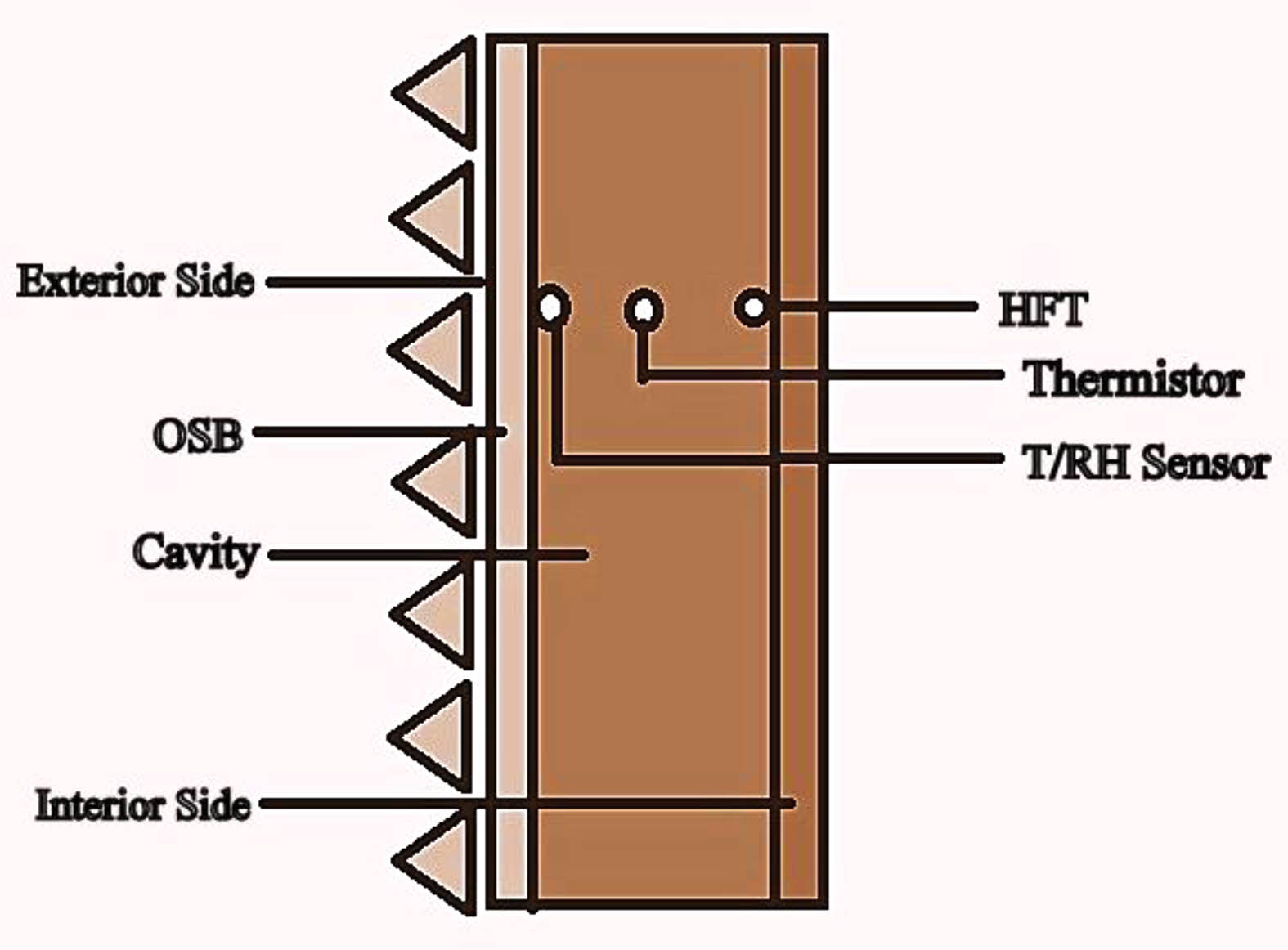
|
Fig. 1 Diagrammatic representation of the test wall. |
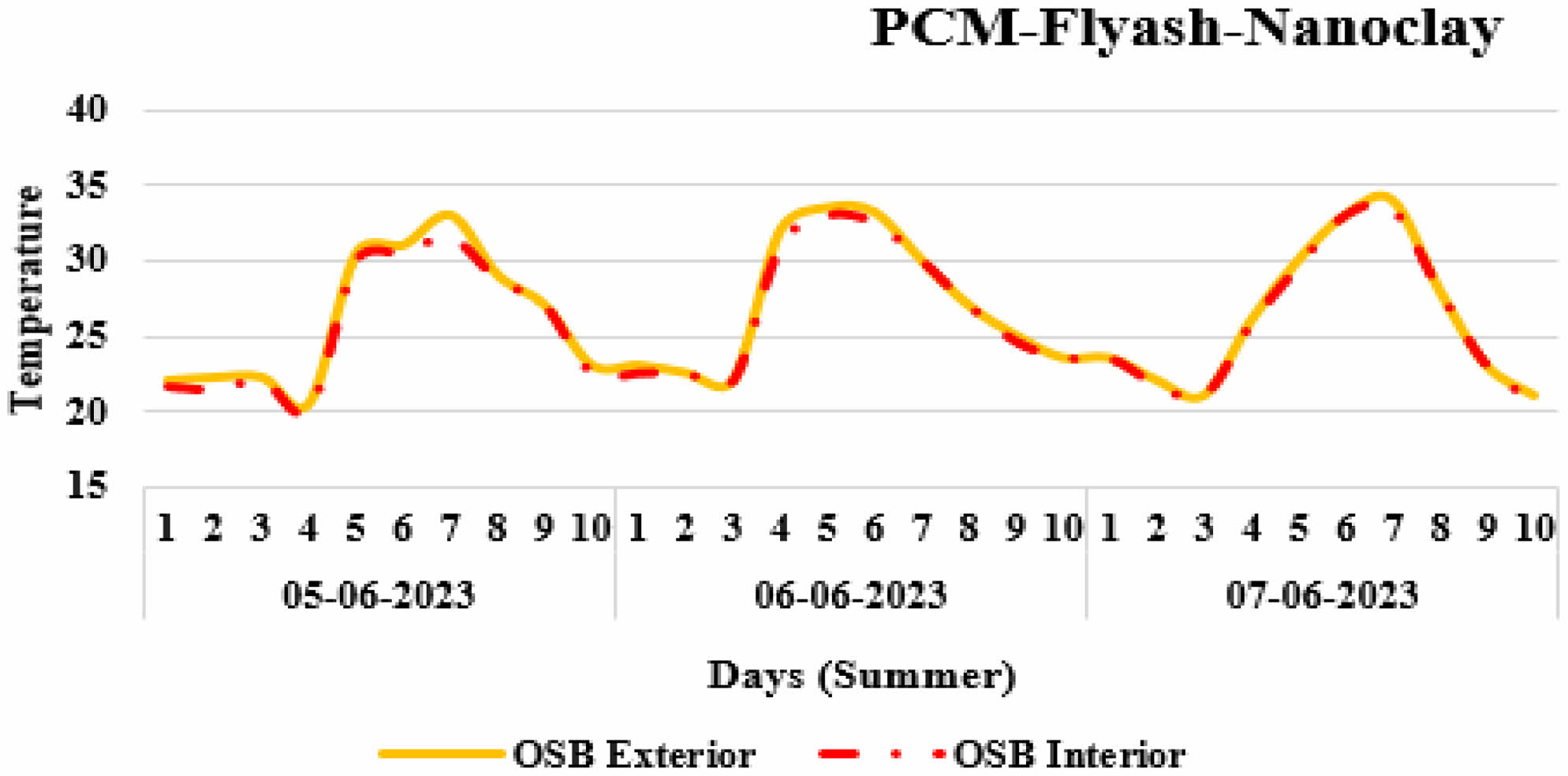
|
Fig. 2 Temperature measured experimentally at different locations within test wall for PCM-flyash-nanoclay during three summer days. |
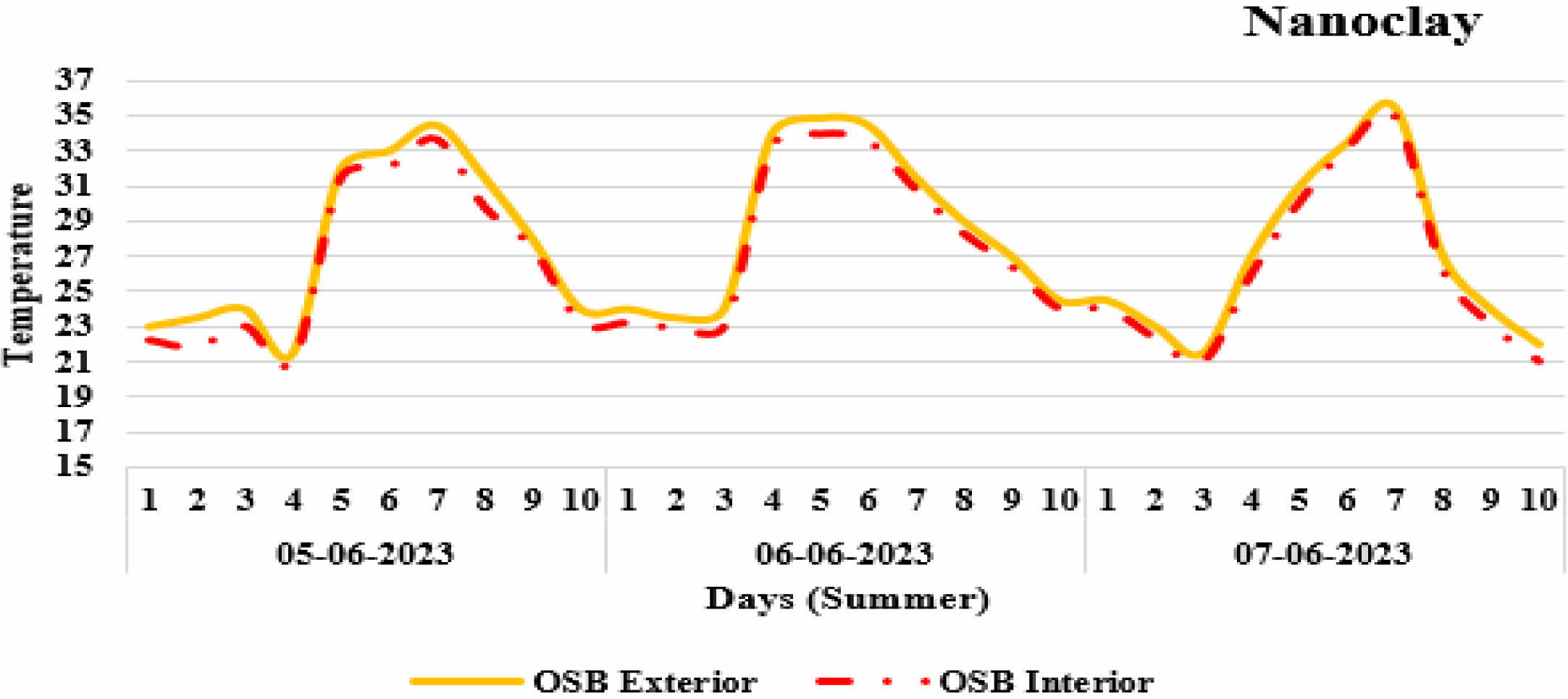
|
Fig. 3 Experimental temperature measurements were made over the course of three summer days at various points inside the test wall for nanoclay. |
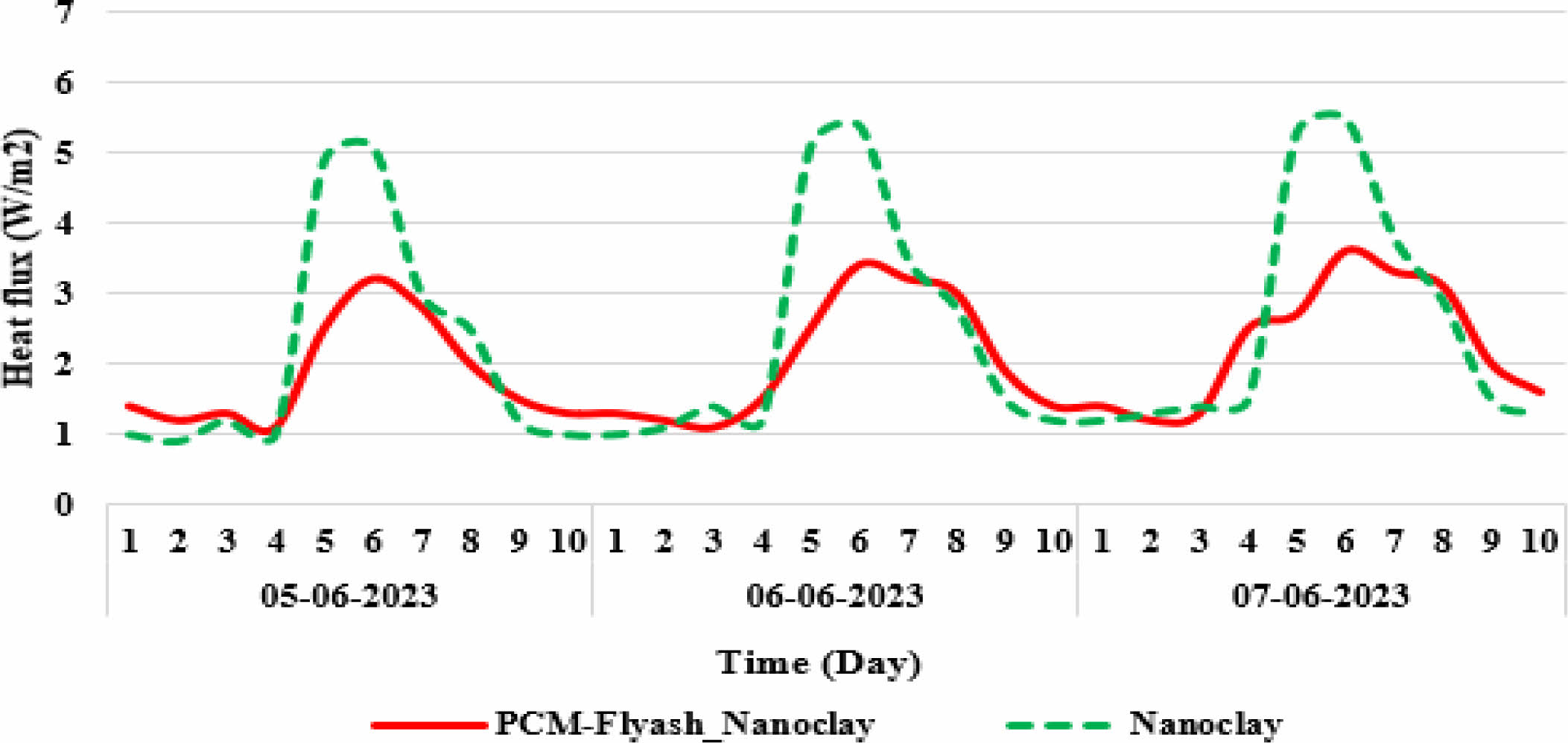
|
Fig. 4 On the wall’s outer surface throughout the course of three summer days, heat flow through the various test wall sections was experimentally monitored. |
The segment that includes both flyash-PCM pellets and nanoclay insulation is referred to in the following talks as “PCM-flyash-nanoclay,” whereas the section that contains just nanoclay insulation is called “Nanoclay.”
Sample temperature and heat flux data
Figure 3 shows the temperature distribution for the “PCM-flyash-Nanoclay” and “Nanoclay” sections throughout three (3) summer days (June 5-7, 2023). The OSB’s external surface and its interior surface, both designated as “OSB Ext.” and “OSB Int.,” respectively, were the sites for the measurements inside each segment. The heat fluxes from the “PCM-Nanoclay” and “nanoclay” portions that were measured on the surface are shown in Fig. 4.
Over the course of the monitoring period, the room’s interior temperature remained consistently regulated between 19 and 21 degrees Celsius. An evident inclination in the temperature distributions of the wall sections was observed, indicating a transition from the exterior to the interior. When comparing the “PCM-Nanoclay” and “Nanoclay” sections, some temperature changes were observed at the internal portion and the exterior of the wallboard. To illustrate the behaviour and effects of PCM, flyash, and nanoclay materials, temperature variations were noted, however they were not excessive. The variations in heat flow and temperature demonstrated the need of using phase change materials in addition to flyash pellets and nanoclay as a ceramic material. Similar patterns were seen in various seasons, depending on the climate, for example, the winter season over the three days. Figure 6-10 Fig. 7 Fig. 8 Fig. 9
Shown in below.
Importance of the Present Work
Our study is important because it has the potential to transform building envelope materials and improve construction energy efficiency. We address important issues in sustainable building design by presenting a unique composite material made of PCM-flyash-nanoclay. Our work’s significance can be comprehended in many fundamental ways:
Novel Composite Material: Phase change materials (PCMs) are combined with waste fly ash and nanoclay insulation to create a novel composite material that is presented in this work. This creative method provides a long-term way to improve thermal insulation and lower building energy usage.
Handling Environmental Concerns: The production of fly ash has sparked environmental concerns due to the growing reliance on coal-fired power generation. We lessen the environmental effects of fly ash disposal and support sustainable waste management methods by recycling fly ash as a crucial component of our composite material.
Progressing with Passive Building Envelopes: Building envelopes are essential for controlling interior temperature and energy consumption. Our study focuses on integrating PCM-flyash-nanoclay composites to enhance the thermal performance of building envelopes. This development is in line with international initiatives to encourage passive building design and lessen dependency on air conditioning and heating equipment.
Improving Energy Efficiency: Our composite material provides improved energy efficiency in buildings by using the insulating qualities of nanoclay and the thermal storage capacities of PCMs. In addition to lowering energy costs and greenhouse gas emissions, this can result in lower heating and cooling loads and help achieve sustainable development goals.
Comparison with Existing Studies
We carried out a thorough analysis of pertinent studies in the areas of building materials and energy-efficient construction techniques in order to place our research within the framework of the body of current knowledge. Many important insights are revealed by a comparison analysis:
Methodology: Although PCMs and nanoclay have been studied in the past for usage in construction materials, our research creatively blends these components with leftover fly ash to produce a special composite. The issues associated with thermal insulation in building envelopes are addressed in a new way by this technique.
Results: A comparative study of numerical models and experimental data shows how effective the PCM-flyash-nanoclay composite is in lowering heat transfer and enhancing thermal performance. Our research offers fresh perspectives on the behavior and possible practical uses of the composite material.
Limitations and Future Directions: Building on the shortcomings found in previous research, this study presents chances for more exploration and improvement. Subsequent research endeavors might delve into the optimization tactics, extended performance tracking, and scalability of the composite material in order to facilitate wider use within the building sector.
Discussion
The thermal efficiency and cost-effectiveness of a novel composite material consisting of fly ash pellets and nanoclay as a ceramic material are evaluated in the current study. The inquiry focuses on the usage of this substance on an outside wall in a hot, humid environment. Experimental tests and numerical calculations were done to assess how well the suggested material performed because it was unlikely to have been digested by AI. For the purpose of confirming the accuracy of the finite element models used for the wall with PCM-flyash-nanoclay insulation, experimental data was gathered. The effect of the aforementioned insulation on the loads put on the walls was then evaluated using numerical models. In our investigation, we replicated wood-framed walls with insulation made of PCM-flyash and cellulose as well as walls with cellulose insulation only.
For the study, the two distinct seasons of summer and winter were chosen. Three days each from the summer and the winter have been examined. To assess the impact of various model placements and distributions on the functionality of the PCM using flyash nanoclay, various scenarios were tested. The use of PCM-flyash-nanoclay in the interior part of the wall cavity produced better results than using solely nanoclay as ceramic for insulation, which was an interesting discovery. The PCM-flyash-nanoclay configuration in the interior part greatly improved the walls of thermal efficiency. Overall, adding PCM to a portion of an outside wall rather than the full cavity can result in improved thermal efficiency at a lower cost. The orientation of the wall had an impact on the possible energy savings that might be achieved by using the existing PCM-flyash-nanoclay, and certain orientations of walls may prove to be more advantageous compared to others, contingent upon the prevailing climatic conditions.
Further investigation is required to optimize the benefits derived from the energy conservation facilitated by the insulation composed of PCM-flyash-nanoclay. Two factors that need to be taken into account are the avoidance of latent heat from freezing from seeping into a building’s interior during the summer and the association between the phase change temperature of the PCM and internal temperatures. A performance evaluation of the insulation, comprised of PCM-flyash-nanoclay, in diverse environmental circumstances necessitates the conduction of tests and simulations. To achieve a more precise estimation of the energy conservation accomplished by the PCM-flyash-nanoclay insulation, a thorough modeling methodology that encompasses all the aforementioned variables becomes imperative.
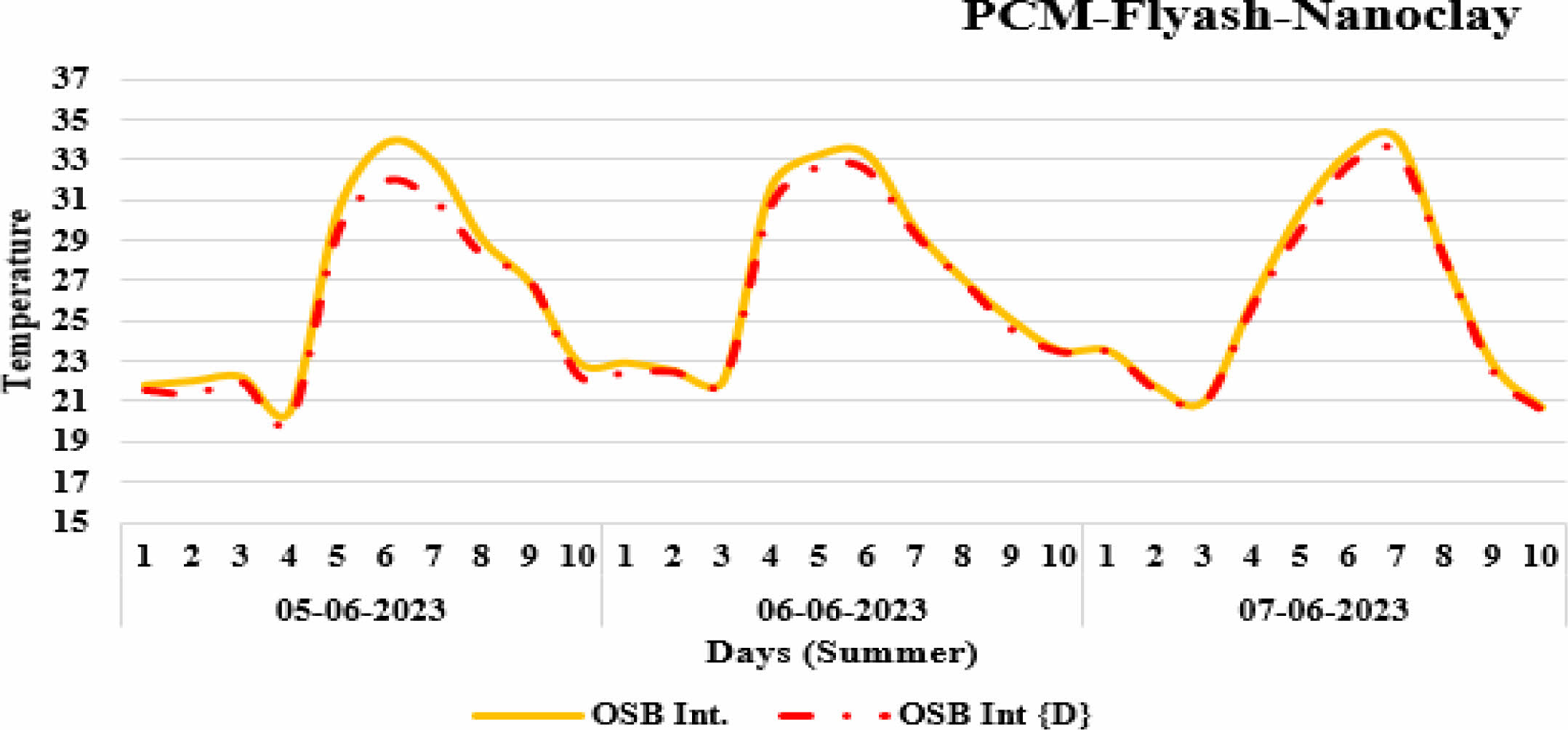
|
Fig. 5 Comparison of Model values with the experimental data for PCM-Flyash-Nanoclay. |
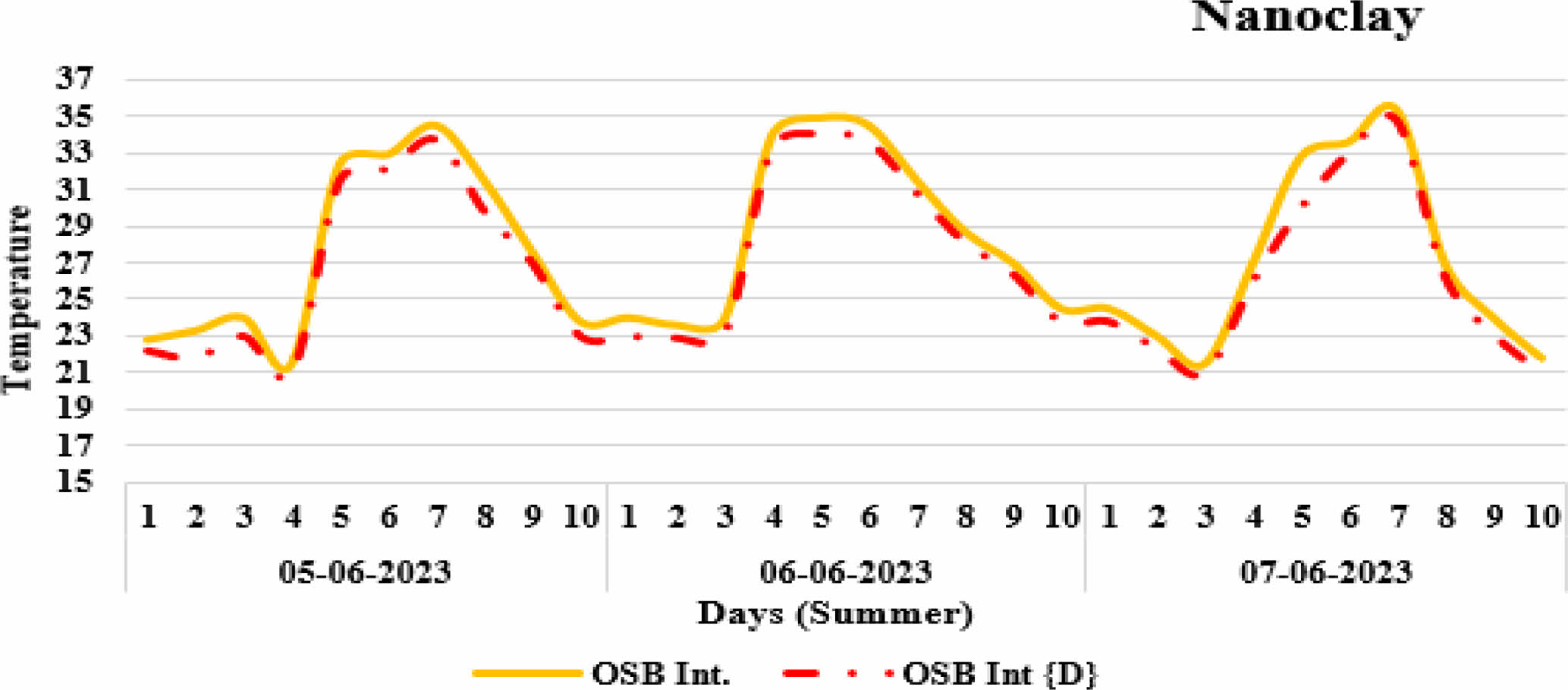
|
Fig. 6 Model values for Nanoclay are compared to experimental data. |
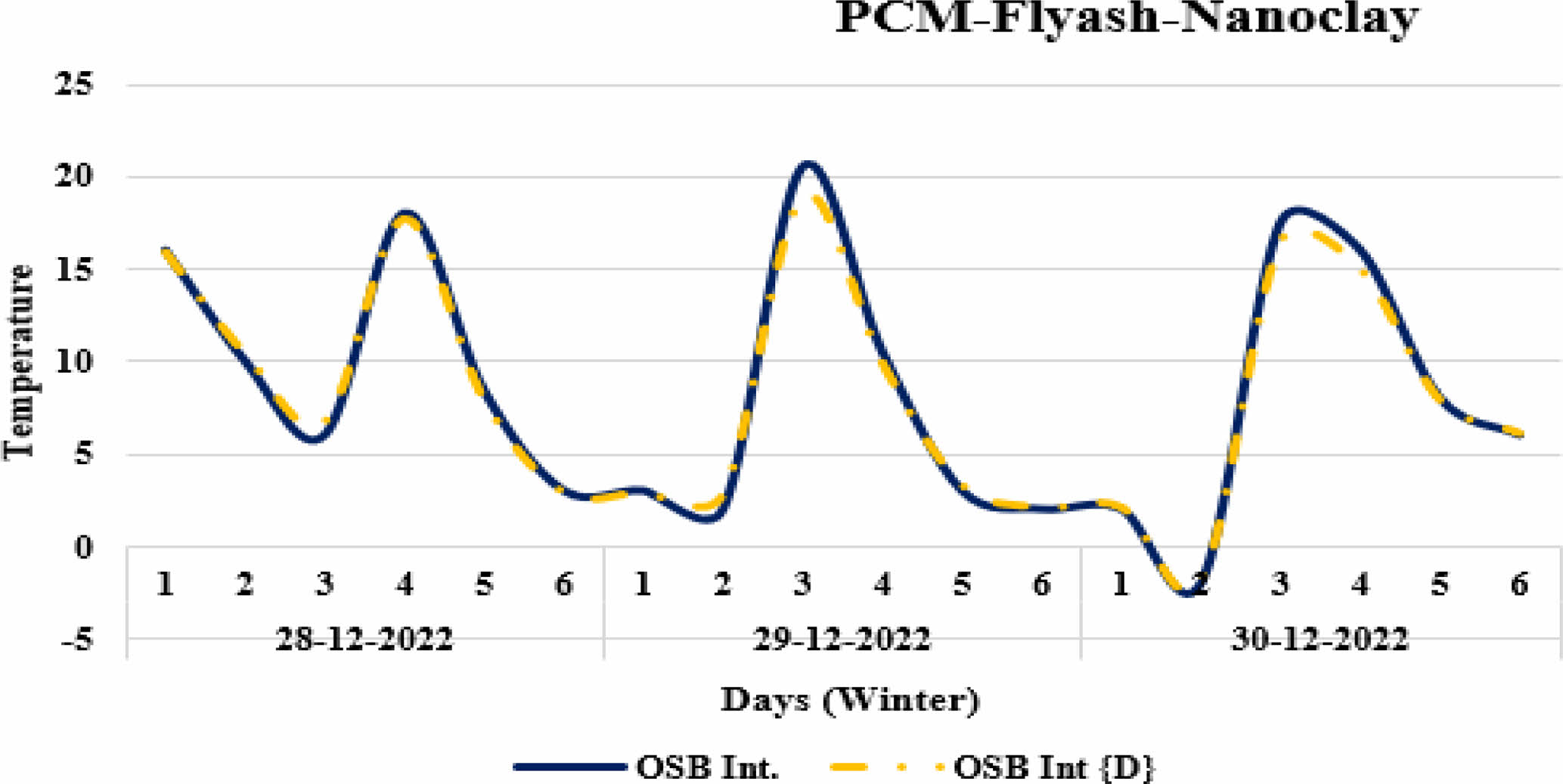
|
Fig. 7 Comparison of Model values with the experimental data for Nanoclay. |
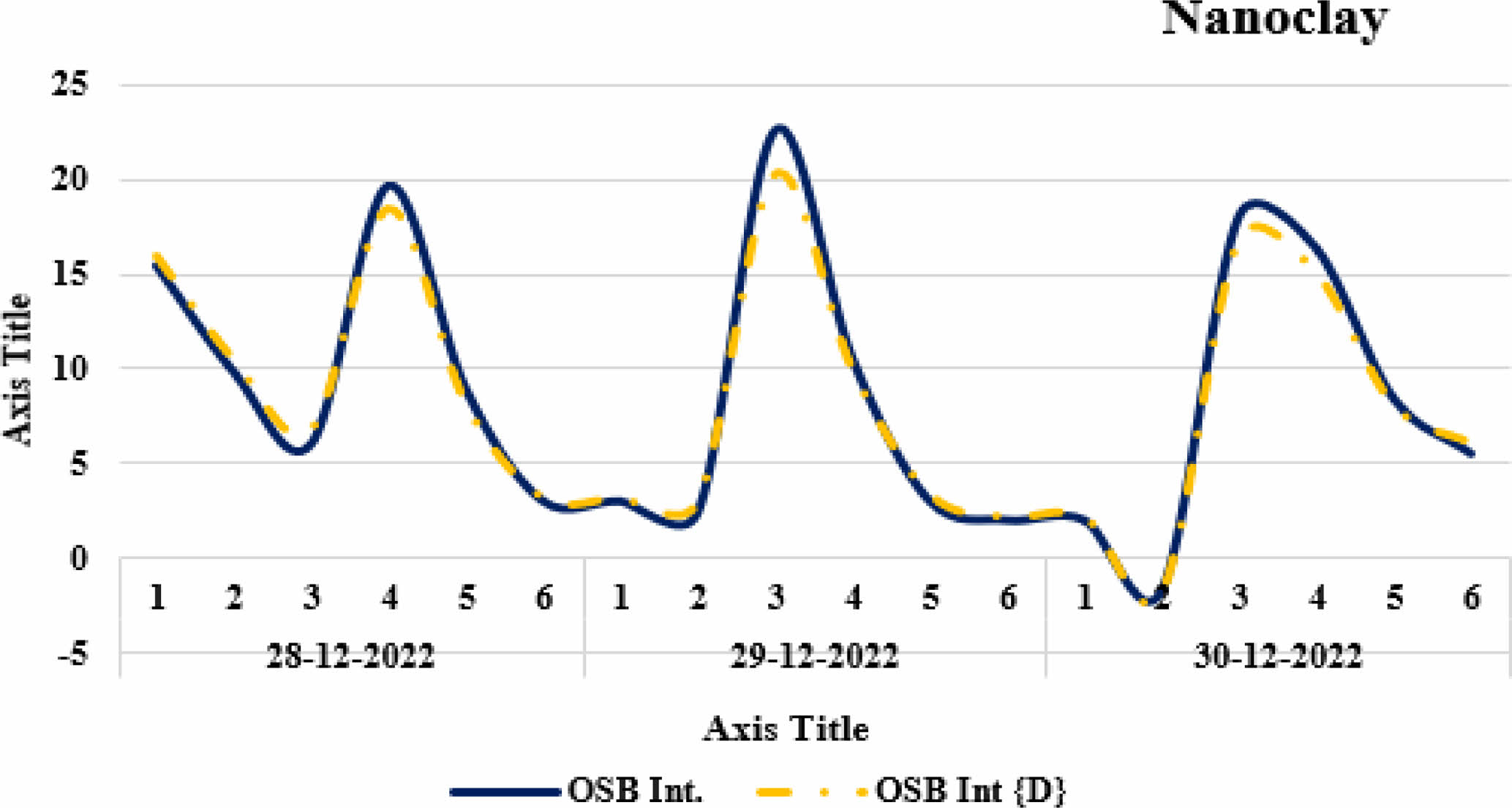
|
Fig. 8 Model values are compared to experimental data for Nanoclay (winter). |

|
Fig. 9 Comparison of model values with the heat flux data (Summer) |
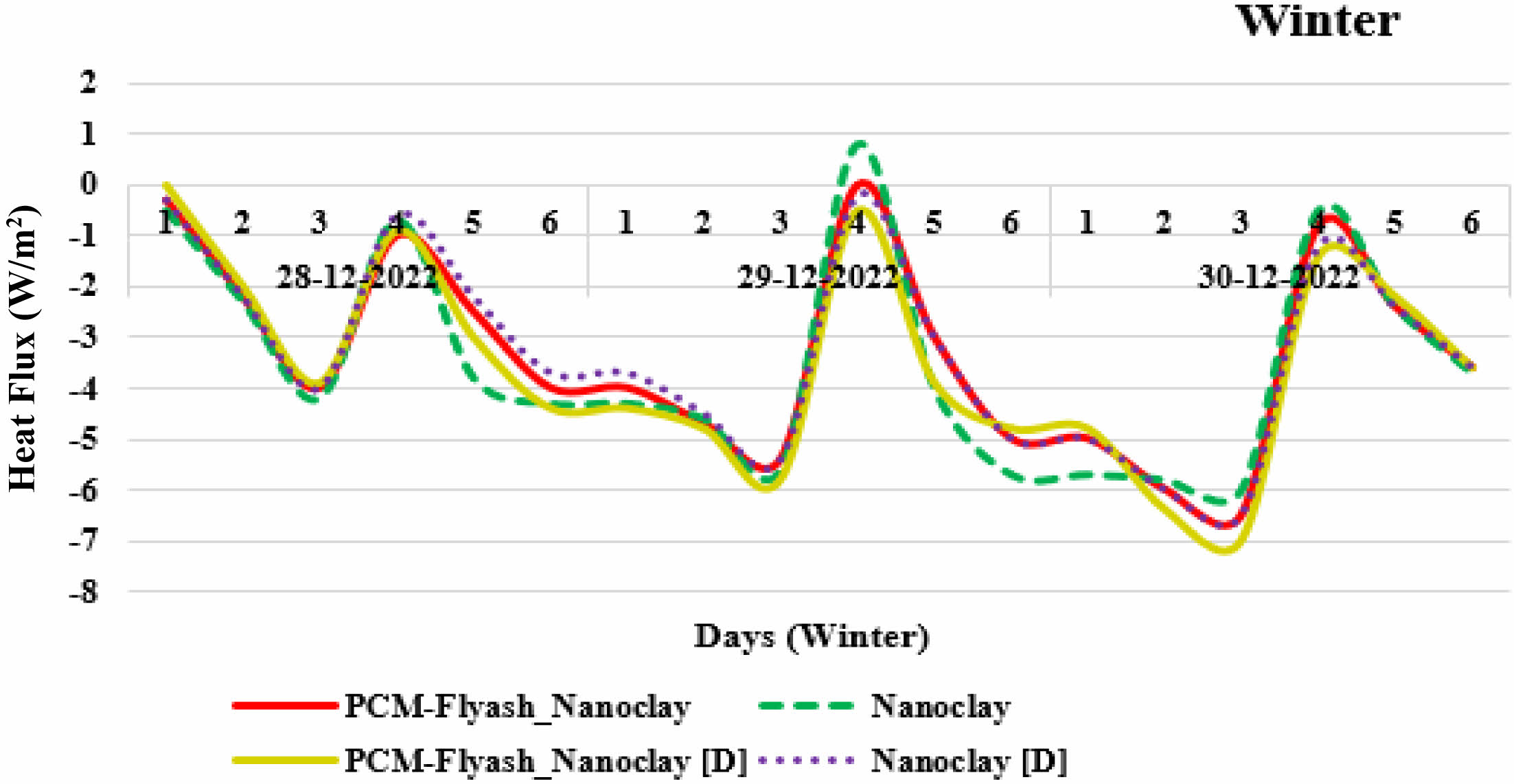
|
Fig. 10 Heat flow measurements (Winter) and model values are compared. |
The evaluation of a novel composite material comprising fly ash pellets and nanoclay as ceramic material in the present study focused on its thermal efficiency and cost-effectiveness when applied to an exterior wall in a hot, humid environment. Both experimental tests and numerical calculations were employed to assess the performance of this material. To validate the accuracy of the finite element models used for walls with PCM-flyash-nanoclay insulation, experimental data were collected. The impact of this insulation on wall loads was then evaluated using numerical models. In our investigation, we compared wood-framed walls with insulation made of PCM-flyash and cellulose to walls with cellulose insulation only.
The study considered two distinct seasons, summer and winter, with examination of three days each from both seasons. Various scenarios were tested to assess the impact of different model placements and distributions on the performance of PCM-flyash-nanoclay. An interesting finding was that using PCM-flyash-nanoclay in the interior part of the wall cavity produced better results than using solely nanoclay as insulation. This configuration significantly improved the thermal efficiency of the walls. Additionally, incorporating PCM into a portion of an exterior wall rather than the entire cavity resulted in improved thermal efficiency at a lower cost. The orientation of the wall also influenced potential energy savings achievable with PCM-flyash-nanoclay, with certain orientations proving more advantageous depending on prevailing climatic conditions.
Further investigation is warranted to optimize the energy conservation benefits of PCM-flyash-nanoclay insulation. Two key considerations include preventing latent heat from freezing seeping into a building’s interior during summer and understanding the relationship between the phase change temperature of PCM and internal temperatures. Performance evaluation of this insulation in diverse environmental circumstances requires additional tests and simulations. A comprehensive modeling methodology encompassing all variables mentioned is essential for a precise estimation of the energy conservation achieved by PCM-flyash-nanoclay insulation.
We would like to express our sincere gratitude to all those who contributed to the successful completion of this research and the preparation of this manuscript.
First and foremost, we extend our appreciation to Hebei Vocational University of Technology and Engineering for providing the necessary resources and support throughout the research process. The conducive research environment and facilities greatly facilitated our experiments and data analysis. Our heartfelt thanks go to the participants and individuals who assisted in the practical aspects of this study. Their cooperation and dedication were invaluable in carrying out the experiments and gathering essential data.
We would like to acknowledge the guidance and mentorship provided by our colleagues and advisors, whose expertise and insights significantly influenced the direction and quality of our research. Their constructive feedback and encouragement were instrumental in shaping this manuscript. Special gratitude is extended to the reviewers and editorial team of the Journal of Ceramic Processing Research for their thorough evaluation and valuable suggestions, which undoubtedly enhanced the overall quality of the manuscript. Lastly, we express our deepest appreciation to family and friends for their unwavering support and understanding during the course of this research. Their encouragement and encouragement have been a source of motivation throughout this journey. This research would not have been possible without the collaborative efforts and support of all those mentioned above. Thank you for being an integral part of this endeavor.
- 1. M. Chaabane, H. Mhiri, and P. Bournot, Energy Convers. Manage. 78 (2014) 897-903.
-

- 2. W.-F. Wu, N. Liu, W.-L. Cheng, and Y. Liu, Energy Convers. Manage. 69 (2013) 174-180.
-

- 3. W. Lu and S.A. Tassou, Appl. Energy 91 (2012) 366-374.
-

- 4. M.J. Huang, P.C. Eames, and B. Norton, Sol. Energy 80 (2006) 1121-1130.
-

- 5. D. Zhou, C.Y. Zhao, and Y. Tian, Appl. Energy 92 (2012) 593-605.
-

- 6. G. Zhou, Y. Zhang, X. Wang, K. Lin, and W. Xiao, Sol. Energy 81 (2007) 1351-1360.
-

- 7. J. Darkwa and O. Su, Appl. Energy 95 (2012) 246-252.
-

- 8. D.W. Hawes and D. Feldman, Sol. Energy Mater. Sol. Cells 27 (1992) 91-101.
-

- 9. L.F. Cabeza, C. Castellon, M. Nogues, M. Medrano, R. Leppers, and O. Zubillaga, Energy Build. 39 (2007) 113-119.
-

- 10. S. Shrestha, W. Miller, T. Stovall, A. Desjarlais, K. Childs, W. Porter, M. Bhandari, and S. Coley, in: Proc. Building Simulation 2011: 12th Conf. International Building Performance Simulation Association, 2011, p. 800-807.
- 11. J. Kosny, E. Kossecka, A. Brzezinski, A. Tleoubaev, and D. Yarbrough, Energy Build. 52 (2012) 122-131.
-

- 12. A.A. Aydin and H. Okutan, Energy Convers. Manage. 68 (2013) 74-81.
-

- 13. J. Kosny, K. Biswas, W. Miller, and S. Kriner, Sol. Energy 86 (2012) 2504-2514.
-

- 14. K. Biswas, S. Kriner, W. Miller, and G. Manlove, in: Thermal performance of exterior envelopes of whole buildings XII.
- 15. E. Meng, H. Yu, G. Zhan, and Y. He, Energy Convers. Manage. 74 (2013) 386-394.
-

- 16. X. Shi, S.A. Memon, W. Tang, H. Cui, and F. Xing, Energy Build. 71 (2014) 80-87.
-

- 17. F. Ascione, N. Bianco, R.F. De Masi, F. de’Rossi, and G.P. Vanoli, Appl. Energy 113 (2014) 990-1007.
-

- 18. S.D. Zwanzig, Y. Lian, and E.G. Brehob, Energy Convers. Manage. 69 (2013) 27-40.
-

- 19. P. Simacek, D. Kubicka, I. Kubikova, F. Homola, M. Pospisil, and J. Chudoba, Fuel 90 (2011) 2473-2479.
-

- 20. S. Bezergianni, A. Kalogianni, and A. Dimitriadis, Fuel 93 (2012) 638-641.
-

- 21. X. Yang, Y. Yuan, N. Zhang, X. Cao, and C. Liu, Sol. Energy 99 (2014) 259-266.
-

- 22. Z.K. Genc, C.A. Canbay, S.S. Acar, M. Sekerci, and M. Genc, J. Therm. Anal. Calorim. 120[3] (2015) 1679-1688.
-

- 23. X. Zhou, H. Xiao, J. Feng, Z. Changrui, and J. Yonggang, Compos. Sci. Technol. 69[7] (2009) 1246-1249.
-

- 24. W. Wang, X. Yang, Y. Fang, J. Ding, and J. Yan, Appl. Energy 86[9] (2009) 1479-1483.
-

- 25. A. Sari, A. Karaipekli, and C. Alkan, Chem. Eng. J. 155[3] (2009) 899-904.
-

- 26. M. Li, Q. Guo, and S. Nutt, Sol. Energy 146 (2017) 1-7.
-

- 27. F. Kuznik, D. David, K. Johannes, and J.J. Roux, Renew. Sustain. Energy Rev. 15[1] (2011) 379-391.
-

- 28. Y. Wu and T. Wang, Energy Convers. Manage. 101 (2015) 164-171.
-

- 29. M. Telkes, in: Proceedings of the Workshop on Solar Energy Storage Subsystems for the Heating and Cooling of Buildings, Charlottesville (Virginia, USA), 1975.
- 30. T. Wang, H. Li, Q.L. Lu, N. Wu, and Y. Jiang, Tenside Surf. Deterg. 54[1] (2017) 32-37.
-

- 31. M. Ahmaruzzaman, Prog. Energy Combust. Sci. 36[3] (2010) 327-363.
-

- 32. H. Wang, C.Y. Song, and Q. Zhang, Fly Ash Compre. Util. 14[4] (2000) 37-41.
- 33. Z.K. Genc, C.A. Canbay, S.S. Acar, M. Sekerci. and M. Genc, J. Therm. Anal. Calorim. 120[3] (2015) 1679-1688.
-

- 34. E. Bontempi, J. Clean. Prod. 162 (2017).
-

- 35. I. Queralt, X. Querol, A. López-Soler, and F. Plana, Fuel 76 (1997) 787-791.
-

- 36. A. Olgun, Y. Erdogan, Y. Ayhan, and B. Zeybek, Ceram. Int. 31 (2005) 153-158.
-

- 37. R. Sokolar and L. Smetanova, Ceram. Int. 36 (2010) 215-221.
-

- 38. M. Knapek, T. Húlan, P. Dobroň, F. Chmelík, A. Trník, and I. Štubňa, Acta Phys. Pol. A 128 (2015) 783-786.
-

- 39. J. Kováč, A. Trník, I. Medved’, I. Štubňa, and L. Vozár, Therm. Sci. 20 (2016) 603-612.
-

- 40. T. Húlan, A. Trník, I. Medved’, I. Štubňa, and T. Kaljuvee, AIP Conf. Proc. 1752 (2016) 040009.
-

- 41. R. Sokolar and L. Vodova, Ceram. Int. 37 (2011) 2879-2885.
-

- 42. A. Zimmer and C.P. Bergmann, Waste Manag. 27 (2007) 59-68.
-

- 43. G. Cultrone and E. Sebastián, Constr. Build. Mater. 23 (2009) 1178-1184.
-

- 44. N. Chandra, P. Sharma, G.L. Pashkov, E.N. Voskresenskaya, S.S. Amritphale, and N.S. Baghel, Waste Manag. 28 (2008) 1993-2002.
-

- 45. L.L. Xu, W. Guo, T. Wang, and N.R. Yang, Constr. Build. Mater. 19 (2005) 243-247.
- 46. S.K. Mukherji, B.B. Machhoya, R.M. Savsani, D.R. Vyas, and T.K. Dan, Br. Ceram. Trans. 92 (1993) 254-257.
- 47. O.C. Sola, M. Yayla, B. Sayin, and C.D. Atis, Adv. Mater. Sci. Eng. 2011 (2011) 430604.
- 48. T. Húlan, A. Trník, T. Kaljuvee, M. Uibu, I. Štubňa, U. Kallavus, and R. Traksmaa, J. Therm. Anal. Calorim. 127 (2017) 79-89.
-

- 49. H.Y. Zhang, Y.C. Zhao, and J.Y. Qi, J. Hazard. Mater. 141 (2007) 106-114.
-

- 50. M. Erol, S. Kuçukbayrak, and A. Ersoy-Meriçboyu, J. Hazard. Mater. 153 (2008) 418-425.
-

- 51. N. Shukla, P. Cao, and J. Kosny, in: ASTM Selected Technical Paper (STP).
 This Article
This Article
-
2024; 25(5): 727-736
Published on Oct 31, 2024
- 10.36410/jcpr.2024.25.5.727
- Received on Mar 7, 2024
- Revised on Apr 26, 2024
- Accepted on Apr 29, 2024
 Services
Services
- Abstract
introduction
proposed methodology
results and discussion
conclusion
- Acknowledgements
- References
- Full Text PDF
Shared
 Correspondence to
Correspondence to
- Jing Chen
-
Hebei Vocational University of Technology and Engineering, Xingtai hebei, 054000, China
Tel : 0319-2273009 Fax: 0319-2273009 - E-mail: chenjing3791@126.com







 Copyright 2019 International Orgranization for Ceramic Processing. All rights reserved.
Copyright 2019 International Orgranization for Ceramic Processing. All rights reserved.